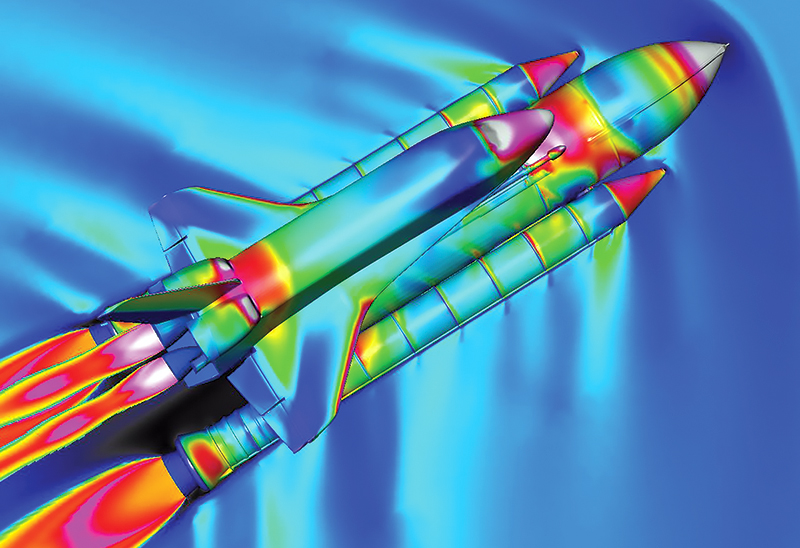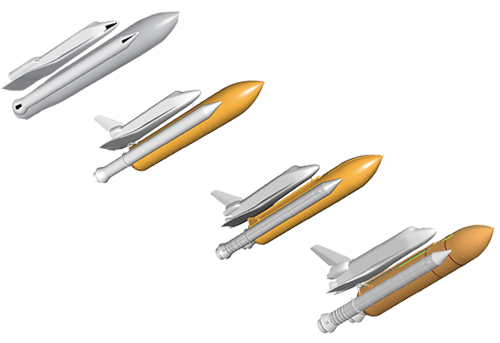
NASA Code Speeds Nation’s Aircraft, Spacecraft Design
NASA Technology
In the late 1980s, NASA engineers were working to improve software to simulate how air flowed around vehicles in flight. But the Space Shuttle posed a distinct challenge. At liftoff, the craft was attached to a huge external fuel tank, which in turn carried two solid rocket boosters. Each of these four bodies generated airflows, which interacted with each other in complex ways. What’s more, as they separated from each other and began moving at different speeds, it got even harder to simulate the air rushing around and between them.
“Simulation of the orbiter detaching from the external tank was the original problem,” says Pieter Buning, who was with the Applied Computational Fluids Branch at Ames Research Center at the time. Following the tragic Challenger disaster of 1986, NASA officials were interested in exploring the possibility of dropping the boosters before they burned out, in case of a malfunction. To better model the fluid dynamics of multiple bodies, Buning and his team lead Joseph Steger proposed using an improvement to computational fluid dynamics (CFD) that is now used by most air- and spacecraft designers in the United States: the overset-grid method.
All CFD software breaks down complex geometries into grids of simple shapes, including breaking up the air around the vehicle model into tiny, three-dimensional bins. Early Shuttle CFD work generated these grids around each major component and then patched them together. Overset grids, on the other hand, overlap and interact with each other, as real airflows would, resulting in more realistic simulations.
NASA developed a suite of software that enables overset grids and is now widely used: A program called Chimera Grid Tools is used to generate the grids. Pegasus preprocessing software integrates them with each other and with all the surfaces being modeled (Spinoff 2018). Buning and colleagues created the OVERFLOW solver that actually runs the simulations. Partnering with a team at Johnson Space Center, they started with a code that had also been created at Ames, and which Buning was using for Shuttle simulations, known as F3D.
“I rewrote it, cleaned it up, made it more user-friendly, and incorporated algorithms from lots of people,” Buning says. “My role has sort of been technology integrator, making it as useful as possible for as many projects as possible.”
Early areas of interest for multi-body CFD beyond spacecraft were helicopters, which might have air moving near the speed of sound over the tips of the blades but relatively gentle airflow around the body, and the release of fuel tanks or missiles, which, under the wrong conditions, could return to hit the aircraft.
Technology Transfer
In the 1990s, Buning transferred to Langley Research Center, where he is now in the Computational AeroSciences Branch. There, he worked for a number of years on commercial transport airplanes and developed relationships with a variety of aircraft companies. OVERFLOW became available through software usage agreements with Langley and was widely acquired throughout the industry and the Department of Defense.
“Getting it out to a lot of organizations helps get me feedback on what people want to do that they can’t do, and I’ll try to get that capability working,” Buning says, noting that this has made the program more flexible, leading to wider adoption. “I worked very hard to make the code user-friendly and put in options a lot of people are interested in.”
Further additions to the software resulted from various NASA projects, such as work on space capsule dynamics, reusable launch vehicles, and rotorcraft. For example, automatically adding grid points to help simulate the tiny whirlwinds that are generated at the tips of helicopter blades also proved useful for other applications.
OVERFLOW is optimized for transonic speeds—velocities approaching or somewhat exceeding the speed of sound—making it applicable to most airline and military applications. Even military jets that fly at twice the speed of sound or more are within OVERFLOW’s range. Only atmospheric reentry speeds are beyond it. While versatile, though, it only uses structured grids, which require less computer memory and processing power than unstructured-grid CFD, although the latter simplifies grid generation for complex shapes. For unstructured-grid CFD, users can obtain programs like FUN3D, also available from Langley.
Benefits
One early adopter of OVERFLOW and the rest of the Chimera Grid Tools suite was Boeing, which now uses the software throughout its commercial, military, space, and research and technology operations for development of planes, rotorcraft, spacecraft, and advanced concepts and hypersonic flight. “The method was proven on the Space Shuttle Launch Vehicle and has been matured over the past 25-plus years. It is an integral part of the Boeing CFD tool set,” says Robb Gregg, chief aerodynamicist at Seattle-based Boeing Commercial Airplanes. He adds that the code provides “exceptionally efficient and accurate flow solutions supporting virtually every product in the company.”
To illustrate the software’s efficiency, Gregg notes that in 1990, it took two-and-a-half years to build a Space Shuttle launch configuration grid system with 16 million points across 20 zones, and another three weeks to run the simulation on a supercomputer. Today, he says, it only takes three weeks to build the grid system for a high-lift commercial transport plane, which includes 300 million points over more than 250 zones, and its simulation can be run in two days.
Other users include about three dozen Department of Defense and other Federal offices; most major defense contractors; more than 60 universities; virtually every U.S. spacecraft manufacturer; aircraft manufacturers like Learjet, Sikorsky, and Honda Aircraft Company; and computer giants such as Microsoft, IBM, Intel, and Hewlett-Packard, which mainly use it to benchmark computers’ CFD performance. Buning says the latest version, released in 2017, went out to about 200 users.
He even recalls helping one engineer from a major manufacturer use OVERFLOW to design a screw compressor for industrial air conditioning units. “If I’ve done my job right and designed the code so it’s general-purpose, hopefully it’s applicable to this kind of problem without too much work,” he says.
In addition to speed, accuracy, and flexibility, Buning says, NASA’s support is another reason the software has caught on. He and colleagues answer users’ questions, help them get started, and troubleshoot problems.
Gregg notes that the code has fostered a mutually beneficial relationship between NASA and Boeing, with the Space Agency making improvements at the company’s suggestion and Boeing’s engineers adding upgrades that find their way into newer versions of the program. “The support we get from NASA has been tremendous,” he says. “The continuous improvement of this technology by NASA, often driven by customers like Boeing, fuels our continued reliance on the tool suite.”
“By disseminating it, we get a lot of feedback, and we learn what people are doing with it and what works and what doesn’t,” Buning adds.

In the early 1980s, NASA’s models for computational fluid dynamics (CFD) modeling of the Space Shuttle consisted of three grids, 10,000 surface points, and 300,000 volume points (far left). As NASA engineers developed the overset-grid method of CFD, creating and improving the OVERFLOW CFD solver and accompanying software throughout the 1980s and ’90s, modeling details and capabilities exploded. By 2004, the Shuttle CFD grid system included 267 overlapping grids with 636,000 surface points and 34.8 million volume points (far right).

Today, NASA’s OVERFLOW CFD solver and accompanying software are able to accurately model the detailed interactions of flows around multiple bodies in flight. Available to the public, they’re used by virtually every U.S. spacecraft manufacturer and many aircraft manufacturers, dozens of Federal agencies, and more than 60 universities.













